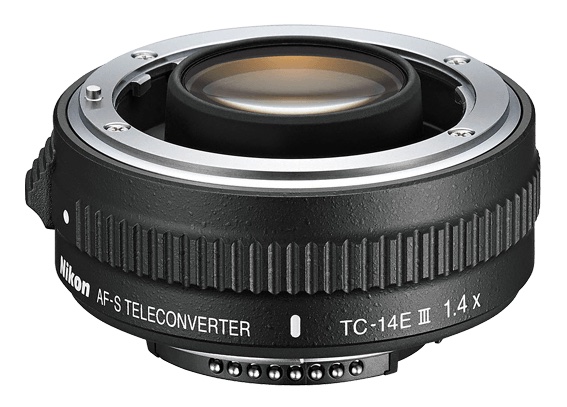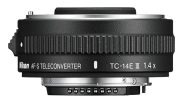Announced
Production status
Original name
System
Nikon F system teleconverters
- Nikon AF-I Teleconverter TC-14E
- Nikon AF-I Teleconverter TC-20E
- Nikon AF-S Teleconverter TC-14E II
- Nikon AF-S Teleconverter TC-14E III
- Nikon AF-S Teleconverter TC-17E II
- Nikon AF-S Teleconverter TC-20E II
- Nikon AF-S Teleconverter TC-20E III Aspherical
- Nikon AF-S Teleconverter TC800-1.25E ED
- Nikon Teleconverter TC-1
- Nikon Teleconverter TC-14
- Nikon Teleconverter TC-14A
- Nikon Teleconverter TC-14B
- Nikon Teleconverter TC-14C
- Nikon Teleconverter TC-2
- Nikon Teleconverter TC-200
- Nikon Teleconverter TC-201
- Nikon Teleconverter TC-300
- Nikon Teleconverter TC-301
Nikon AF-S Teleconverter TC-14E III
Teleconverter • Digital era
Specification
| Optical design: | |
Magnification factor: | 1.4x |
| 35mm full frame | |
| Nikon F | |
| 7 elements - 4 groups | |
| Physical characteristics: | |
| 190g | |
| ⌀64×24.5mm | |
| Dust-proof and water-resistant barrel | |
| Yes |
Source of data
- Manufacturer's technical data.
Manufacturer description #1
MELVILLE, NY (May 14, 2014 at 12:01 A.M. EDT) –Today, Nikon Inc. announced the new AF-S NIKKOR 400mm f/2.8E FL ED VR lens and AF-S Teleconverter TC-14E III, engineered to give professional and passionate photographers optical excellence and exceptional telephoto capabilities. The new 400mm f/2.8 lens is lighter and more durable than its acclaimed predecessor, inviting professional and passionate shooters to capture the thrill of sports, action and wildlife with staggering clarity and precision, even in challenging light. The new TC-14 E III Teleconverter is an ideal companion for many NIKKOR telephoto lenses, offering users a focal length boost while maintaining clarity and sharpness.
“The new AF-S NIKKOR 400mm f/2.8E FL ED VR has been evolved to meet the needs of today’s sports, wildlife and multi-media photographers, well beyond the premier precision optics; it is much lighter, and has well thought-out controls and features that aid in creating super-sharp images even from extreme distances,” said Masahiro Horie, Director of Marketing and Planning, Nikon Inc. “Together with the AF-S Teleconverter TC-14E III, the new 400mm lens and many other NIKKOR lenses will help photographers go the distance to get their shot.”
The New AF-S NIKKOR 400mm f/2.8E FL ED VR: Superior Optics, Superb Handling
The new 400mm f/2.8 super-telephoto lens delivers upon the NIKKOR promise of uncompromising performance, thanks to overall enhancements to the optical characteristics of the lens, which go beyond simply enhancing image quality. With a refined optical formula, those who shoot fast action sports from a distance or rapidly moving wildlife will appreciate the improved autofocus (AF), exposure accuracy and speed. The lens now contains two fluorite elements that, together with two Extra-Low Dispersion (ED) glass elements and Nano Crystal Coat, helps ensure outstanding performance with minimal chromatic aberration and flaring. The internal construction of the lens comprises 16 elements in 12 groups, and features an electromagnetic diaphragm, similar to that employed in the AF-S NIKKOR 800mm f/5.6 lens. Denoted by the “E” designation, this feature allows for stable exposures during high speed shooting, such as the 11 frames-per-second (fps) possible with the Nikon D4S HD-SLR. Additionally, the lens employs a nine-blade rounded diaphragm that creates a circular, natural looking out of focus area – a requirement for action and wildlife shooters who need clear separation between the subject and the background.
The refined construction of this lens has additional benefits, creating a beautifully balanced instrument for professionals that is nearly two full pounds (816 grams) lighter than its predecessor, tempting the user to shoot handheld when needed. Whether trackside or courtside, photographers will value Nikon’s Vibration Reduction (VR) technology with up to four stops of image stabilization*, and the addition of the new VR Sport Mode. When shooting action, especially on a monopod, the VR Sport Mode recognizes a panning motion to provide accurate compensation for camera shake, resulting in super-sharp images, with motion blur where the photographer intended. For working in challenging environments, the lens features a protective front meniscus element with a fluorine coating, which resists dirt and moisture on the front of the lens. Other pro-minded features include the addition of a rotating tripod collar for seamless switching between compositions, and buttons on the lens barrel compatible with the new AF functions of the Nikon D4S.
AF-S Teleconverter TC-14E III
Nikon’s long legacy and expertise in optical engineering is substantiated with this new 1.4x teleconverter that retains the lens’ image quality, even at wide-open apertures. This new teleconverter effectively multiplies the focal length of many NIKKOR lenses by 1.4x, while resulting in only a one-stop loss of exposure. Especially useful for nature and sports photographers, the enhanced optical system reduces chromatic lens aberration, while preserving the accuracy of the AF system.
The construction of the teleconverter has been significantly upgraded for both durability and optical brilliance. Comprised of seven elements within four groups, the outer elements feature a fluorine coating for enhanced resistance to dirt and water droplets. For added durability, the lens barrel has been designed for increased moisture and dust resistance.
Manufacturer description #2
Increase the reach of compatible AF-S NIKKOR lenses like the AF-S NIKKOR 400mm f/2.8E FL ED VR or the AF-S NIKKOR 70-200mm f/2.8G ED VR without sacrificing image quality, autofocus accuracy, metering or even VR image stabilization. Optimized for sports, action, wildlife and press photographers, the AF-S Teleconverter TC-14E III achieves superb 1.4x enlargement with only a 1-stop loss of light. Fluorine coatings protect the front and rear surfaces, and a durable lens barrel with water-drop resistance ensures the AF-S Teleconverter TC-14E III can hold up to professional use. Maximize the performance and reach of your NIKKOR lens.
The AF-S Teleconverter TC-14E III increases the reach of compatible AF-S lenses by 40% with only a 1-stop loss of light. Turn the AF-S NIKKOR 70–200mm f/2.8G ED VR into a 98–280mm f/4 lens or the AF-S NIKKOR 400mm f/2.8E FL ED VR into a 560mm f/4 lens. Enjoy the speed, performance and lightness of smaller telephoto lenses with the reach of a super-telephoto lens.
The AF-S Teleconverter TC-14E III features an optical design that draws peak performance from compatible AF-S NIKKOR lenses, including fast primes and zoom lenses. Enjoy stunning depiction—nearly the same image quality that a lens alone produces—outstanding autofocus accuracy, full metering performance and even VR image stabilization.
If you shoot sports, action or wildlife, you know landing great shots sometimes means getting dirty. The AF-S Teleconverter TC-14E III is designed to be as rugged as the lenses it modifies. Fluorine coatings on the front and rear surfaces repel dirt and water droplets for clear views and easy removal, and the durable lens barrel also provides dust- and water-droplet resistance.
Manufacturer description #3
Lenses compatible with the TC-14E II, but incompatible with the AF-S TELECONVERTER TC-14E III:
- AF-S Nikkor 300mm f/2.8D IF-ED II
- AF-S Nikkor 300mm f/2.8D IF-ED
- AF-S Nikkor 300mm f/4D IF-ED
- AF-I Nikkor 300mm f/2.8D IF-ED
- AF-S Nikkor 400mm f/2.8D IF-ED II
- AF-S Nikkor 400mm f/2.8D IF-ED
- AF-I Nikkor 400mm f/2.8D IF-ED
- AF-S Nikkor 500mm f/4D IF-ED II
- AF-S Nikkor 500mm f/4D IF-ED
- AF-I Nikkor 500mm f/4D IF-ED
- AF-S Nikkor 600mm f/4D IF-ED II
- AF-S Nikkor 600mm f/4D IF-ED
- AF-I Nikkor 600mm f/4D IF-ED
- AF-S Zoom-Nikkor 80-200mm f/2.8D IF-ED
Because the maximum aperture coupling ridge and minimum aperture signal post are eliminated with the AF-S TELECONVERTER TC-14E III, “FEE” is displayed on the camera body when these lenses are used, disabling shooting.

